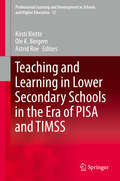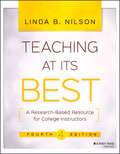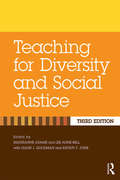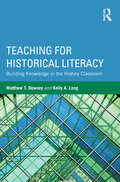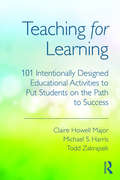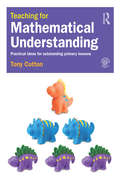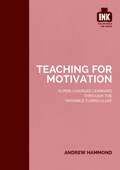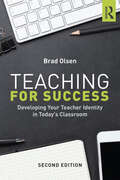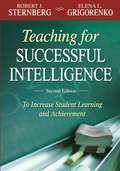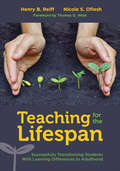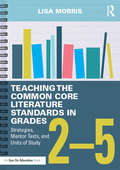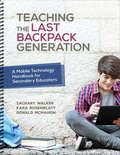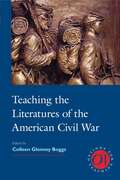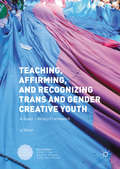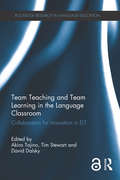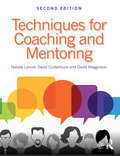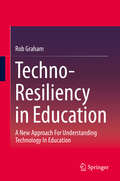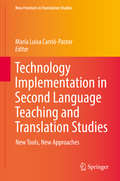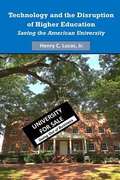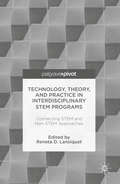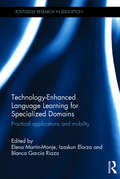- Table View
- List View
Teaching and Learning in Lower Secondary Schools in the Era of PISA and TIMSS
by Kirsti Klette Ole K. Bergem Astrid RoeThis book explores teaching and learning in lower secondary classrooms in the three PISA domains science, mathematics and reading. Based on extensive video documentation from science, math and reading classrooms in Norwegian secondary schooling, it analyzes how offered and experienced teaching and learning opportunities in these three subject areas support students' learning. The in-depth investigations of video documentation are combined with analysis of the Norwegian PISA results in order to understand how teaching and learning in science, mathematics and reading can be improved. Recent reviews indicate that instructional practice does make a difference to students learning - and is more important than other factors including students' socioeconomic background, class size, classroom climate, and teachers' experience and formal training. This book opens the discussion on a European basis about contemporary challenges in teaching and learning in secondary schooling. Norway as a test bed is particularly interesting due to its long tradition with national curricula, and its unitary and non- streamed structure. Furthermore, ideas of educational progressivism and students' active ways of working (such as individualized teaching, adapted teaching, inquiry based teaching etc. ) have for a long time been actively promoted within Norwegian educational policies. The book draws on analyses that combine expertise in psychometrics and video-based micro genetic classroom studies with expertise in domain-specific instruction (math, science and reading). It feeds the conversation how issues of communication patterns are dealt with and made productive within different instructional formats, and presents possibilities to compare and analyze instructional formats and discursive practices for students' learning.
Teaching at Its Best: A Research-Based Resource for College Instructors
by Linda B. NilsonThe classic teaching toolbox, updated with new research and ideas Teaching at Its Best is the bestselling, research-based toolbox for college instructors at any level, in any higher education setting. Packed with practical guidance, proven techniques, and expert perspectives, this book helps instructors improve student learning both face-to-face and online. This new fourth edition features five new chapters on building critical thinking into course design, creating a welcoming classroom environment, helping students learn how to learn, giving and receiving feedback, and teaching in multiple modes, along with the latest research and new questions to facilitate faculty discussion. Topics include new coverage of the flipped classroom, cutting-edge technologies, self-regulated learning, the mental processes involved in learning and memory, and more, in the accessible format and easy-to-understand style that has made this book a much-valued resource among college faculty. Good instructors are always looking for ways to improve student learning. With college classrooms becoming increasingly varied by age, ability, and experience, the need for fresh ideas and techniques has never been greater. This book provides a wealth of research-backed practices that apply across the board. Teach students practical, real-world problem solving Interpret student ratings accurately Boost motivation and help students understand how they learn Explore alternative techniques, formats, activities, and exercises Given the ever-growing body of research on student learning, faculty now have many more choices of effective teaching strategies than they used to have, along with many more ways to achieve excellence in the classroom. Teaching at Its Best is an invaluable toolbox for refreshing your approach, and providing the exceptional education your students deserve.
Teaching for Diversity and Social Justice
by Maurianne Adams Lee Anne BellFor twenty years, Teaching for Diversity and Social Justice has been the definitive sourcebook of theoretical foundations, pedagogical and design frameworks, and curricular models for social justice teaching practice. Thoroughly revised and updated, this third edition continues in the tradition of its predecessors to cover the most relevant issues and controversies in social justice education in a practical, hands-on format. Filled with ready-to-apply activities and discussion questions, this book provides teachers and facilitators with an accessible pedagogical approach to issues of oppression in classrooms.? The revised edition also focuses on providing students the tools needed to apply their learning about these issues. Features new to this edition include: A new bridging chapter focusing on the core concepts that need to be included in all SJE practice and illustrating ways of "getting started" teaching foundational core concepts and processes. A new chapter addressing the possibilities for adapting social justice education to online and blended courses. Expanded overview sections that highlight the historical contexts and legacies of oppression, opportunities for action and change, and the intersections among forms of oppression. Added coverage of key topics for teaching social justice issues, such as establishing a positive classroom climate, institutional and social manifestations of oppression, the global implications of contemporary SJE work, and action steps for addressing injustice. New and revised material for each of the core chapters in the book complemented by fully-developed online teaching designs, including over 150 downloadables, activities, and handouts on the book’s Companion Website (www.routledgetextbooks.com/textbooks/_author/teachingfordiversity). A classic for teachers across disciplines, Teaching for Diversity and Social Justice presents a thoughtful, well-constructed, and inclusive foundation for engaging students in the complex and often daunting problems of discrimination and inequality in American society.
Teaching for Historical Literacy: Building Knowledge in the History Classroom
by Matthew T. Downey Kelly A. LongTeaching for Historical Literacy combines the elements of historical literacy into a coherent instructional framework for teachers. It identifies the role of historical literacy, analyzes its importance in the evolving educational landscape, and details the action steps necessary for teachers to implement its principles throughout a unit. These steps are drawn from the reflections of real teachers, grounded in educational research, and consistent with the Common Core State Standards. The instructional arc formed by authors Matthew T. Downey and Kelly A. Long takes teachers from start to finish, from managing the prior learning of students to developing their metacognition and creating synthesis at the end of a unit of study. It includes introducing topics by creating a conceptual overview, helping students collect and analyze evidence, and engaging students in multiple kinds of learning, including factual, procedural, conceptual, and metacognitive. This book is a must-have resource for teachers and students of teaching interested in improving their instructional skills, building historical literacy, and being at the forefront of the evolving field of history education.
Teaching for Learning: 101 Intentionally Designed Educational Activities to Put Students on the Path to Success
by Todd Zakrajsek Michael S. Harris Claire Howell MajorDespite a growing body of research on teaching methods, instructors lack a comprehensive resource that highlights and synthesizes proven approaches. Teaching for Learning fills that gap. Each of the one hundred and one entries: describes an approach and lists its essential features and elements demonstrates how that approach has been used in education, including specific examples from different disciplines reviews findings from the research literature describes techniques to improve effectiveness. Teaching for Learning provides instructors with a resource grounded in the academic knowledge base, written in an easily accessible, engaging, and practical style.
Teaching for Mathematical Understanding: Practical ideas for outstanding primary lessons
by Tony CottonTeaching for Mathematical Understanding develops the subject knowledge support and practical ideas from Tony Cotton's Understanding and Teaching Primary Mathematics into resources for full lessons. With an emphasis on developing outstanding lessons using a problem-solving approach, this highly practical guide is packed with activities that all trainee and practising teachers can use in the primary classroom. Covering each area of mathematics, every activity offers helpful step-by-step guidance, including teaching and learning objectives; resources; lesson outlines; ideas for differentiation; assessment for learning and key probing questions. Also featured in this text are call-outs to the information contained in the book's companion website, a shared site with a range of relevant resources to support and consolidate your learning. Teaching for Mathematical Understanding is an essential text for all trainee and practising teachers looking for inspiration and guidance towards outstanding mathematics teaching. Companion website features include: Video clips in which primary school teachers demonstrate concepts covered in the book through teaching to a real class PowerPoint presentations which provide support for those using the book as part of a teacher training course updated weblinks to external sites with useful teaching information and resources.
Teaching for Motivation: Super-charged learning through 'The Invisible Curriculum'
by Andrew HammondThe Invisible Curriculum series gives teachers the secret ingredients that can fully unlock a child's learning potential. In Teaching for Motivation, Andrew Hammond proves that identifying a child's motivational needs and wants is key to powerful learning.
Teaching for Motivation: Super-charged learning through 'The Invisible Curriculum'
by Andrew HammondThe Invisible Curriculum series gives teachers the secret ingredients that can fully unlock a child's learning potential. In Teaching for Motivation, Andrew Hammond proves that identifying a child's motivational needs and wants is key to powerful learning.
Teaching for Success: Developing Your Teacher Identity in Today's Classroom
by Brad OlsenTeaching For Success is a comprehensive guide for navigating the process of becoming an effective teacher in the wake of contemporary and systemic challenges. Focusing on the core concept of teacher identity in clear, invigorating prose, the book illuminates how teachers can arrange, adjust, and assemble their own personal and professional teaching influences in conjunction with educational research into a coherent, unique, and successful whole. Olsen’s attention to classroom practice, social justice issues, personal satisfaction, and teacher success stories offers a sharp and useful guide for teacher development. This revised second edition has been updated and includes a new chapter that guides both new and experienced teachers through emerging, thorny issues in educational policy and practice, including high-stakes testing, blended learning, the demands of networking, and the Common Core State Standards.
Teaching for Successful Intelligence: To Increase Student Learning and Achievement
by Robert Sternberg Elena GrigorenkoCoauthored by two internationally renowned educators and researchers, this resource helps teachers strengthen their classroom practice with lessons that promote successful intelligence--a set of abilities that allow students to adapt and succeed within their environment, make the most of their strengths, and learn to compensate for their weaknesses.
Teaching for the Lifespan: Successfully Transitioning Students With Learning Differences to Adulthood
by Henry B. Reiff Nicole S. OfieshYour step-by-step guide to successful transition planning Finally, here’s a practical guide that makes transition planning easier. Backed by the latest research in learning and development, Teaching for the Lifespan provides you with the pedagogical best practices to promote your students’ strengths for life-long success. You’ll benefit from: A deep understanding of the educational, vocational, social, and emotional dimensions of adulthood for students with learning differences Techniques to help students with learning differences develop an awareness of proactive behaviors Strategies to help all learners achieve the demands of the Common Core and high-stakes assessments through Universal Design for Learning (UDL)
Teaching for the Lifespan: Successfully Transitioning Students With Learning Differences to Adulthood
by Henry B. Reiff Nicole S. OfieshYour step-by-step guide to successful transition planning Finally, here’s a practical guide that makes transition planning easier. Backed by the latest research in learning and development, Teaching for the Lifespan provides you with the pedagogical best practices to promote your students’ strengths for life-long success. You’ll benefit from: A deep understanding of the educational, vocational, social, and emotional dimensions of adulthood for students with learning differences Techniques to help students with learning differences develop an awareness of proactive behaviors Strategies to help all learners achieve the demands of the Common Core and high-stakes assessments through Universal Design for Learning (UDL)
Teaching the Common Core Literature Standards in Grades 2-5: Strategies, Mentor Texts, and Units of Study
by Lisa MorrisShifting your literature instruction to meet the Common Core can be tricky. The standards are specific about how students should analyze characters, themes, point of view, and more. In this new book, Lisa Morris makes it easy by taking you through the standards and offering tons of practical strategies, tools, and mentor texts for grades 2-5. She shows you how to combine the standards into effective units of study so that you can teach with depth rather than worry about coverage. Topics covered include: Teaching questioning, inferring, and author’s purpose; Guiding readers to look at themes and write summaries; Showing students how to recognize structural elements of literature; Teaching the craft of writing and vocabulary development; and Helping students analyse characters and character development. Throughout this highly practical book, you’ll find a variety of charts and other graphic organizers that can be easily adapted for classroom use. A list of suggested mentor texts is also available as a free eResource from our website, www.routledge.com/books/details/9781138856172.
Teaching the Last Backpack Generation: A Mobile Technology Handbook for Secondary Educators
by Zachary Walker Kara Rosenblatt Don McMahonDon’t just know how to use mobile technology. Know how to use it to transform learning. This refreshingly easy-to-use workbook shows how to make mobile devices a natural part of lessons, no matter the content. Discover practical device management skills, fun strategies students will love, and helpful resources to extend professional learning.
Teaching the Last Backpack Generation: A Mobile Technology Handbook for Secondary Educators
by Zachary Walker Kara Rosenblatt Don McMahonDon’t just know how to use mobile technology. Know how to use it to transform learning. This refreshingly easy-to-use workbook shows how to make mobile devices a natural part of lessons, no matter the content. Discover practical device management skills, fun strategies students will love, and helpful resources to extend professional learning.
Teaching the Literatures of the American Civil War (Options for Teaching #39)
by Colleen Glenney BoggsWhen Abraham Lincoln met Harriet Beecher Stowe in 1863, he reportedly greeted her as "the little woman who wrote the book that started this Great War." To this day, Uncle Tom's Cabin serves as a touchstone for the war. Yet few works have been selected to represent the Civil War's literature, even though historians have filled libraries with books on the war itself.This volume helps teachers address the following questions: What is the relation of canonical works to the multitude of occasional texts that were penned in response to the Civil War, and how can students understand them together? Should an approach to war literature reflect the chronology of historical events or focus instead on thematic clusters, generic forms, and theoretical concerns? How do we introduce students to archival materials that sometimes support, at other times resist, the close reading practices in which they have been trained?Twenty-three essays cover such topics as visiting historical sites to teach the literature, using digital materials, teaching with anthologies; soldiers' dime novels, Confederate women's diaries, songs, speeches; the conflicted theme of treason, and the double-edged theme of brotherhood; how battlefield photographs synthesize fact and fiction; and the roles in the war played by women, by slaves, and by African American troops. A section of the volume provides a wealth of resources for teachers.
Teaching, Affirming, and Recognizing Trans and Gender Creative Youth: A Queer Literacy Framework (Queer Studies and Education)
by Sj MillerWinner of the 2018 Outstanding Book by the Michigan Council Teachers of EnglishChoice magazine as an Outstanding Academic Title for 2018Winner of the 2017 AERA Division K (Teaching and Teacher Education) Exemplary Research AwardThis book draws upon a queer literacy framework to map out examples for teaching literacy across pre-K-12 schooling. To date, there are no comprehensive Pre-K-12 texts for literacy teacher educators and theorists to use to show successful models of how practicing classroom teachers affirm differential (a)gender bodied realities across curriculum and schooling practices. This book aims to highlight how these enactments can be made readily conscious to teachers as a reminder that gender normativity has established violent and unstable social and educational climates for the millennial generation of lesbian, gay, bisexual, transgender, intersex, (a)gender/(a)sexual, gender creative, and questioning youth.
Team Teaching and Team Learning in the Language Classroom: Collaboration for innovation in ELT (Routledge Research in Language Education)
by Akira Tajino Tim Stewart David DalskyThis book reignites discussion on the importance of collaboration and innovation in language education. The pivotal difference highlighted in this volume is the concept of team learning through collaborative relationships such as team teaching. It explores ways in which team learning happens in ELT environments and what emerges from these explorations is a more robust concept of team learning in language education. Coupled with this deeper understanding, the value of participant research is emphasised by defining the notion of ‘team’ to include all participants in the educational experience. Authors in this volume position practice ahead of theory as they struggle to make sense of the complex phenomena of language teaching and learning. The focus of this book is on the nexus between ELT theory and practice as viewed through the lens of collaboration. The volume aims to add to the current knowledge base in order to bridge the theory-practice gap regarding collaboration for innovation in language classrooms.
Techniques for Coaching and Mentoring
by David Clutterbuck David Megginson Natalie LancerThis is a fully revised and updated second edition of the successful Techniques for Coaching and Mentoring, also incorporating the best bits of its sister text Further Techniques for Coaching and Mentoring. The book presents a comprehensive and critical overview of the wide range of tools and techniques available to coaches and mentors. With a strong academic underpinning, it explores a wide range of approaches, and provides techniques both for use with clients and to support professional development of the coach or mentor. Key features include: Easy-to-use resources and techniques for one-to-one coaching; Case studies throughout the text, helping to put theory into practice; An overview of different theoretical approaches; A dedicated section on ‘themes for the coach’ discussing coaching across cultures, evaluating your coaching and looking after yourself as a coach; and Downloadable worksheets for each technique. Techniques for Coaching and Mentoring 2nd Edition is an invaluable resource for professional coaches and mentors looking to enhance their practice, and for students of coaching and mentoring.
Techno-Resiliency in Education
by Rob GrahamThis book formulates a greater understanding of how to enable a capacity for building social professional practice related to technology-enriched teaching and learning (TETL) specific, but not limited to, educational settings. This book comes at a time when many in education are struggling to provide a technology enriched learning experience for students who are entering classrooms with high expectations for such an experience. The focus on the protective factors and identified resilient professional practices, instead of on well documented and commonly cited risk factors and barriers that impede the effective integration of TETL, represents a distinguishing feature of this work. By attempting to better understand and document how two schools that were classified as resilient in their use of technology have been able to overcome risk factors (e. g. , budgetary constraints, a lack of resources, a lack of training, technological support issues), this book will offer the unique concept of techno-resiliency and some of its deeper insights and strategies.
Technology Implementation in Second Language Teaching and Translation Studies
by María Luisa Carrió-PastorThis monograph mainly focuses on the idea that language teaching in higher education involves making use of new approaches and technology. It identifies the key determinants of the materials needed to improve language teaching on the basis of the actual experimental research included in the respective contributions. Thanks to its unique perspective, the book offers a distinctive approach to addressing empirical research on second language teaching, translator training and technology. As universities are some of the best arenas for analyzing teaching techniques for various subjects, higher education teachers can use this book to thoroughly prepare for the application of pilot studies and learn more about students' responses to new teaching and translation techniques. An enlightening guide for scholars and students with an academic interest in acquiring the basic principles of language teaching and translation, this book mainly provides actual cases in which the implementation of technology was useful to second language teachers and translation trainers. As the authors are experienced scholars, readers will not only come to understand how to use new teaching strategies, but also discover that the proposals described in each chapter can be useful to any level of second language training for teachers and translators.
Technology and Testing: Improving Educational and Psychological Measurement
by Fritz DrasgowFrom early answer sheets filled in with number 2 pencils, to tests administered by mainframe computers, to assessments wholly constructed by computers, it is clear that technology is changing the field of educational and psychological measurement. The numerous and rapid advances have immediate impact on test creators, assessment professionals, and those who implement and analyze assessments. This comprehensive new volume brings together leading experts on the issues posed by technological applications in testing, with chapters on game-based assessment, testing with simulations, video assessment, computerized test development, large-scale test delivery, model choice, validity, and error issues. Including an overview of existing literature and ground-breaking research, each chapter considers the technological, practical, and ethical considerations of this rapidly-changing area. Ideal for researchers and professionals in testing and assessment, Technology and Testing provides a critical and in-depth look at one of the most pressing topics in educational testing today.
Technology and the Disruption of Higher Education: Saving The American University
by Henry C. LucasThe purpose of this book is to explore how new technology has the potential to transform higher education. However, this same technology also has the potential to disrupt universities. Much depends on how administrators, faculty and students apply technologically enhanced learning. Technology and the Disruption of Higher Education presents details on MOOCs, blended, flipped and online classes and their role in transforming higher education based on the author's experiences teaching all of these types of courses. <P><P>These technology-enabled approaches to teaching and learning offer tremendous opportunities to schools, but they also threaten the traditional university. The book identifies some of these threats and opportunities and offers suggested strategies to take advantage of the technology. Is this technology enough to save the university system? While new ways of teaching and learning are exciting, they are only part of the puzzle. Radical change beyond what happens in the classroom is needed if our higher education system is to continue to flourish and some of these ideas are discussed in the last chapter of the book. The book is a call to action for educators to realize that the technology is both transformational and disruptive, and that some universities are going to fail in the next 15 years.
Technology, Theory, and Practice in Interdisciplinary STEM Programs
by Reneta D. LansiquotThis book highlights models for promoting interdisciplinary thinking and an appreciation for interdisciplinary understanding among students in STEM-related fields. Studentsmajoring in science, technology, engineering, and mathematics often perceivethat courses in their major are not related to the general education liberalarts courses required for their degrees. This separation prevents the transfer of skills between their generaleducation courses and their degree pursuits. The false dichotomy is particularlyimportant because solving the daunting challenges of the twenty-firstcentury--such as drug-resistant bacteria, scarcity of natural resources, andclimate change--requires global citizens armed with robust, complex abilitieswho can integrate interdisciplinary concepts with bold technologies. Contributors to this book explore ways in which this dichotomy can be overcome.
Technology-Enhanced Language Learning for Specialized Domains: Practical applications and mobility (Routledge Research in Education)
by Izaskun Elorza Blanca García Riaza Elena Martín-MonjeTechnology-Enhanced Language Learning for Specialized Domains provides an exploration of the latest developments in technology-enhanced learning and the processing of languages for specific purposes. It combines theoretical and applied research from an interdisciplinary angle, covering general issues related to learning languages with computers, assessment, mobile-assisted language learning, the new language massive open online courses, corpus-based research and computer-assisted aspects of translation. The chapters in this collection include contributions from a number of international experts in the field with a wide range of experience in the use of technologies to enhance the language learning process. The essays have been brought together precisely in recognition of the demand for this kind of specialised tuition, offering state-of-the-art technological and methodological innovation and practical applications. The topics covered revolve around the practical consequences of the current possibilites of mobility for both learners and teachers, as well as the applicability of updated technological advances to language learning and teaching, particularly in specialized domains. This is achieved through the description and discussion of practical examples of those applications in a variety of educational contexts. At the beginning of each thematic section, readers will find an introductory chapter which contextualises the topic and links the different examples discussed. Drawing together rich primary research and empirical studies related to specialized tuition and the processing of languages, Technology-Enhanced Language Learning for Specialized Domains will be an invaluable resource for academics, researchers and postgraduate students in the fields of education, computer assisted language learning, languages and linguistics, and language teaching.
